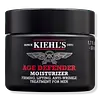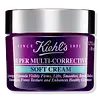What's inside
What's inside
 Key Ingredients
Key Ingredients

 Benefits
Benefits

 Concerns
Concerns

 Ingredients Side-by-side
Ingredients Side-by-side

Water
Skin ConditioningGlycerin
HumectantDimethicone
EmollientAlcohol Denat.
AntimicrobialSucrose Stearate
EmollientOrbignya Oleifera Seed Oil
EmollientPentaerythrityl Tetraethylhexanoate
EmollientPoly C10-30 Alkyl Acrylate
Emulsion StabilisingTheobroma Cacao Seed Butter
EmollientHydrogenated Polyisobutene
EmollientOctyldodecanol
EmollientStearic Acid
CleansingPalmitic Acid
EmollientSynthetic Wax
AbrasiveSodium Polyacrylate
AbsorbentPhenoxyethanol
PreservativeCapryloyl Salicylic Acid
ExfoliatingParfum
MaskingPolyurethane-2
Acrylates/C10-30 Alkyl Acrylate Crosspolymer
Emulsion StabilisingPolymethyl Methacrylate
Chlorphenesin
AntimicrobialXanthan Gum
EmulsifyingSodium Hydroxide
BufferingLimonene
PerfumingHydrolyzed Linseed Extract
Skin ConditioningDimethiconol
EmollientTocopherol
AntioxidantCaffeine
Skin ConditioningPentaerythrityl Tetra-Di-T-Butyl Hydroxyhydrocinnamate
AntioxidantGlycine Soja Protein
EmulsifyingMyristic Acid
CleansingAscorbyl Glucoside
AntioxidantAdenosine
Skin ConditioningVaccinium Myrtillus Fruit Extract
Skin ConditioningSodium Benzoate
MaskingCaprylyl Glycol
EmollientDimethyl Mea
BufferingSaccharum Officinarum Extract
MoisturisingSodium Cocoyl Glutamate
CleansingLinalool
PerfumingEthylhexylglycerin
Skin ConditioningSodium Dehydroacetate
PreservativeCitrus Aurantium Dulcis Fruit Water
MaskingCitrus Limon Fruit Extract
MaskingPotassium Sorbate
PreservativeAcer Saccharum Extract
Skin ConditioningCitral
PerfumingWater, Glycerin, Dimethicone, Alcohol Denat., Sucrose Stearate, Orbignya Oleifera Seed Oil, Pentaerythrityl Tetraethylhexanoate, Poly C10-30 Alkyl Acrylate, Theobroma Cacao Seed Butter, Hydrogenated Polyisobutene, Octyldodecanol, Stearic Acid, Palmitic Acid, Synthetic Wax, Sodium Polyacrylate, Phenoxyethanol, Capryloyl Salicylic Acid, Parfum, Polyurethane-2, Acrylates/C10-30 Alkyl Acrylate Crosspolymer, Polymethyl Methacrylate, Chlorphenesin, Xanthan Gum, Sodium Hydroxide, Limonene, Hydrolyzed Linseed Extract, Dimethiconol, Tocopherol, Caffeine, Pentaerythrityl Tetra-Di-T-Butyl Hydroxyhydrocinnamate, Glycine Soja Protein, Myristic Acid, Ascorbyl Glucoside, Adenosine, Vaccinium Myrtillus Fruit Extract, Sodium Benzoate, Caprylyl Glycol, Dimethyl Mea, Saccharum Officinarum Extract, Sodium Cocoyl Glutamate, Linalool, Ethylhexylglycerin, Sodium Dehydroacetate, Citrus Aurantium Dulcis Fruit Water, Citrus Limon Fruit Extract, Potassium Sorbate, Acer Saccharum Extract, Citral
Water
Skin ConditioningGlycerin
HumectantHydroxypropyl Tetrahydropyrantriol
Skin ConditioningNiacinamide
SmoothingAlcohol Denat.
AntimicrobialDimethicone
EmollientButylene Glycol
HumectantPropylene Glycol
HumectantBetaine
HumectantCoco-Caprylate/Caprate
EmollientSqualane
EmollientCaprylyl Methicone
Skin ConditioningAmmonium Acryloyldimethyltaurate/Vp Copolymer
Hydroxyethylpiperazine Ethane Sulfonic Acid
BufferingInonotus Obliquus Extract
Skin ConditioningAdenosine
Skin ConditioningCapryloyl Glycine
CleansingMenthoxypropanediol
MaskingMethyldihydrojasmonate
MaskingPalmitoyl Tetrapeptide-7
Skin ConditioningPalmitoyl Tripeptide-1
Skin ConditioningSodium Hydroxide
BufferingTetrasodium Glutamate Diacetate
Tocopheryl Acetate
AntioxidantHydrogenated Lecithin
EmulsifyingAcrylates/C10-30 Alkyl Acrylate Crosspolymer
Emulsion StabilisingAluminum Starch Octenylsuccinate
AbsorbentCarbomer
Emulsion StabilisingCetearyl Alcohol
EmollientCetearyl Glucoside
EmulsifyingPolysorbate 20
EmulsifyingSodium Lactate
BufferingT-Butyl Alcohol
PerfumingDimethiconol
EmollientStearyl Dimethicone
EmollientChlorphenesin
AntimicrobialPhenoxyethanol
PreservativeWater, Glycerin, Hydroxypropyl Tetrahydropyrantriol, Niacinamide, Alcohol Denat., Dimethicone, Butylene Glycol, Propylene Glycol, Betaine, Coco-Caprylate/Caprate, Squalane, Caprylyl Methicone, Ammonium Acryloyldimethyltaurate/Vp Copolymer, Hydroxyethylpiperazine Ethane Sulfonic Acid, Inonotus Obliquus Extract, Adenosine, Capryloyl Glycine, Menthoxypropanediol, Methyldihydrojasmonate, Palmitoyl Tetrapeptide-7, Palmitoyl Tripeptide-1, Sodium Hydroxide, Tetrasodium Glutamate Diacetate, Tocopheryl Acetate, Hydrogenated Lecithin, Acrylates/C10-30 Alkyl Acrylate Crosspolymer, Aluminum Starch Octenylsuccinate, Carbomer, Cetearyl Alcohol, Cetearyl Glucoside, Polysorbate 20, Sodium Lactate, T-Butyl Alcohol, Dimethiconol, Stearyl Dimethicone, Chlorphenesin, Phenoxyethanol
Ingredients Explained
These ingredients are found in both products.
Ingredients higher up in an ingredient list are typically present in a larger amount.
Acrylates/C10-30 Alkyl Acrylate Crosspolymer is a synthetic polymer. It is used to thicken and improve the texture of products. Due to its properties, it can prevent water and oil ingredients from separating.
Adenosine is in every living organism. It is one of four components in nucleic acids that helps store our DNA.
Adenosine has many benefits when used. These benefits include hydrating the skin, smoothing skin, and reducing wrinkles. Once applied, adenosine increases collagen production. It also helps with improving firmness and tissue repair.
Studies have found adenosine may also help with wound healing.
In skincare products, Adenosine is usually derived from yeast.
Learn more about AdenosineAlcohol Denat. is an alcohol with a denaturant property. It is created by mixing ethanol with other additives.
This ingredient gets a bad rep because it is irritating and drying - mostly due to its astringent property. Astringents draw out natural oils in tissue, constricting pores and leaving your skin dried out.
However, alcohol denat. is not all that bad.
Due to its low molecular weight, alcohol denat. tends to evaporate quickly. One study on pig skin found half of applied alcohol evaporated in 10 seconds and less than 3% stayed on skin.
This also helps other ingredients become better absorbed upon application.
Studies are conflicted about whether this ingredient causes skin dehydration. One study from 2005 found adding emollients to propanol-based sanitizer decreased skin dryness and irritation. Another study found irritation only occurs if your skin is already damaged.
Small amounts of alcohol are generally tolerated by oily skin or people who live in humid environments.
The rule of thumb is if this alcohol is near the end of an ingredients list, it will probably not affect your skin much.
Also...
This ingredient has antimicrobial and solvent properties.
The antimicrobial property helps preserve products and increase their shelf life. As a solvent, it helps dissolve other ingredients.
Other types of astringent alcohols include:
Learn more about Alcohol Denat.Chlorphenesin is a synthetic preservative. It helps protect a product against bacteria in order to extend shelf life. In most cases, Chlorphenesin is paired with other preservatives such as phenoxyethanol and caprylyl glycol.
Chlorphenesin is a biocide. This means it is able to help fight the microorganisms on our skin. It is also able to fight odor-releasing bacteria.
Chlorphenesin is soluble in both water and glycerin.
Studies show Chlorphenesin is easily absorbed by our skin. You should speak with a skincare professional if you have concerns about using Chlorphenesin.
Learn more about ChlorphenesinDimethicone is a type of synthetic silicone created from natural materials such as quartz.
What it does:
Dimethicone comes in different viscosities:
Depending on the viscosity, dimethicone has different properties.
Ingredients lists don't always show which type is used, so we recommend reaching out to the brand if you have questions about the viscosity.
This ingredient is unlikely to cause irritation because it does not get absorbed into skin. However, people with silicone allergies should be careful about using this ingredient.
Note: Dimethicone may contribute to pilling. This is because it is not oil or water soluble, so pilling may occur when layered with products. When mixed with heavy oils in a formula, the outcome is also quite greasy.
Learn more about DimethiconeDimethiconol is a silicone that resembles the popular dimethicone. Like other silicones, it is an emollient. Emollients create a thin film on skin to prevent moisture from escaping.
This ingredient helps to create a silky texture and improve spreadability. Due to its high molecular weight and thickness, it is often combined with cyclopentasiloxane.
Glycerin is already naturally found in your skin. It helps moisturize and protect your skin.
A study from 2016 found glycerin to be more effective as a humectant than AHAs and hyaluronic acid.
As a humectant, it helps the skin stay hydrated by pulling moisture to your skin. The low molecular weight of glycerin allows it to pull moisture into the deeper layers of your skin.
Hydrated skin improves your skin barrier; Your skin barrier helps protect against irritants and bacteria.
Glycerin has also been found to have antimicrobial and antiviral properties. Due to these properties, glycerin is often used in wound and burn treatments.
In cosmetics, glycerin is usually derived from plants such as soybean or palm. However, it can also be sourced from animals, such as tallow or animal fat.
This ingredient is organic, colorless, odorless, and non-toxic.
Glycerin is the name for this ingredient in American English. British English uses Glycerol/Glycerine.
Learn more about GlycerinPhenoxyethanol is a preservative that has germicide, antimicrobial, and aromatic properties. Studies show that phenoxyethanol can prevent microbial growth. By itself, it has a scent that is similar to that of a rose.
It's often used in formulations along with Caprylyl Glycol to preserve the shelf life of products.
Sodium Hydroxide is also known as lye or caustic soda. It is used to adjust the pH of products; many ingredients require a specific pH to be effective.
In small amounts, sodium hydroxide is considered safe to use. However, large amounts may cause chemical burns due to its high alkaline.
Your skin has a natural pH and acid mantle. This acid mantle helps prevent harmful bacteria from breaking through. The acid mantle also helps keep your skin hydrated.
"Alkaline" refers to a high pH level. A low pH level would be considered acidic.
Learn more about Sodium HydroxideWater. It's the most common cosmetic ingredient of all. You'll usually see it at the top of ingredient lists, meaning that it makes up the largest part of the product.
So why is it so popular? Water most often acts as a solvent - this means that it helps dissolve other ingredients into the formulation.
You'll also recognize water as that liquid we all need to stay alive. If you see this, drink a glass of water. Stay hydrated!
Learn more about Water